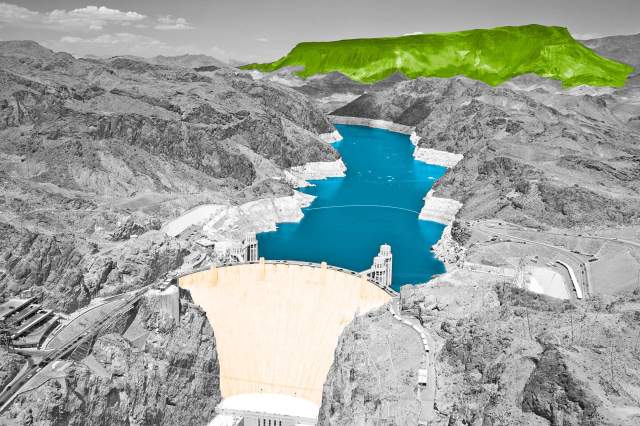
Flood Damage Was a Major Reason for the Hoover Dam’s Construction
The Colorado River helped carve out the American West and Southwest, flowing for 1,450 miles and providing water to seven states: Colorado, New Mexico, Utah, Wyoming, Arizona, California, and Nevada. However, thanks to snowmelt from the Rocky Mountains, the river was also prone to flooding in the early 20th century, causing major damage to farmland in Southern California. A series of floods between 1905 and 1907 led to serious discussions about damming the river. Engineers quickly considered other big benefits of taming the river, too, including providing a steady stream of drinking and irrigation water to developing cities and farmlands, and using the river as a source of hydropower.

Building the Dam Meant First Building an Entire City
Constructing a large-scale dam meant hiring a massive workforce: By the end of the project, the employee roster swelled to 21,000 people. An average day had 3,500 workers reporting to the construction site, though that number rose during busy periods, like in June 1934, when as many as 5,218 men reported to the jobsite per day. Bringing in that many workers (and their families) meant the federal government had to have a plan — which is how the town of Boulder City, Nevada, came to exist.
In December 1928, President Calvin Coolidge authorized the creation of Boulder City on federal land specifically to house workers. Construction of the town’s buildings began in 1931. Families were housed in cottages, while single men slept in dormitories, and meals were provided in a jumbo-sized mess hall that served 6,000 meals per day. Boulder City was also equipped with a state-of-the-art hospital to handle jobsite accidents, a fire department, a train station, and a movie theater.

Constructing the Hoover Dam Required Massive Amounts of Concrete
Building a structure as large as the Hoover Dam requires massive amounts of construction materials. The dam reaches 726 feet tall, a whopping 171 feet taller than the Washington Monument, and the dam’s base is as thick as two football fields are long. Reaching those dimensions required engineers and builders to use a substantial amount of concrete — so much that the sheer volume (4.5 million cubic yards) could be used to pave a cross-country road starting in San Francisco and ending in New York City.
Ultimately, the dam had a $49 million price tag — about $882 million today — with an additional $71 million for its power plant and generators. However, the dam’s construction costs were fully repaid (with interest) by 1987, thanks to the sale of the electrical power it generated (and continues to generate).
More Interesting Reads

The Hoover Dam Originally Had A Different Name
The Hoover Dam gets its name from President Herbert Hoover, though it nearly had a different one thanks to the influence of the Great Depression. Before becoming the 31st President in 1929, Hoover was a successful mining engineer and businessman who was familiar with the Colorado River; as secretary of commerce, he had proposed damming the river to prevent flooding and to provide water for Southern California. Once underway, the dam — which was overseen by Hoover during his presidency — was called the Boulder Canyon Project. However, in September 1930, Secretary of the Interior Ray Lyman Wilbur announced at a ceremony marking the start of construction that the dam’s name would be changed to honor Hoover’s role in its development.
Construction continued through the Great Depression, but Hoover’s presidency did not. President Franklin D. Roosevelt entered the Oval Office, and in 1933 his pick for secretary of the interior decided to backtrack on the name due to personal animosity and public anger over Hoover’s handling of the Great Depression, once again calling it the Boulder Dam. Both names were used interchangeably until April 1947, when President Harry S. Truman approved the final name: Hoover Dam.

Hoover Dam Was Heavily Guarded During World War II
In the lead-up to World War II, the federal government became increasingly worried that the Hoover Dam would be a target of sabotage from Axis forces, knocking out its ability to provide electricity and water. In 1939, public officials discussed shielding the dam by closing its power plant to the public, while also heavily restricting (and scrutinizing) employees who entered.
In November of that year, the State Department received word from the U.S. Embassy in Mexico that German agents had plotted to bomb the dam, hoping to knock out its high-voltage power lines and slow aviation manufacturing in nearby Los Angeles. A massive effort to protect the dam was soon underway — including the addition of floodlights, installation of nets that could snag approaching boats, and increased patrols on Lake Mead (which was closed to the public). However, the government’s move to protect the dam remained classified, with public officials claiming rumors of foreign sabotage were “ridiculous” and unfounded. The incident was kept under wraps until 2001, when historians uncovered unsealed documents at the National Archives.

Lake Mead Is the Country’s Largest Reservoir
Dams rely on on reservoirs, aka human-made lakes that store water. As Hoover Dam is one of the largest dams in the world, it makes sense that its reservoir would be massive, and it is; Lake Mead is the largest reservoir in the U.S. and one of the largest in the world. The expansive lake is multipurpose; it provides drinking water for nearly 25 million people, and its 550 miles of shoreline have been used by outdoor enthusiasts since it became the country’s first national recreation area, managed by the National Park Service, in 1964.












